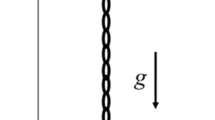Summary
An extended form of Hamilton's principle is developed for systems whose constituent particles change with time. By a suitable choice of system boundary it is demonstrated that in some cases stationary forms of the principle are possible. A simple example is considered.
Similar content being viewed by others
References
L. Meirovitch,Methods of Analytical Dynamics, McGraw-Hill Advanced Engineering Series, New York (1970).
Y. C. Fung,Foundations of Solid Mechanics, Prentice-Hall International Series in Dynamics, London (1965).
M. A. Biot,Variational Principles in Heat Transfer, Oxford Mathematical Monographs, 1970.
B. A. Boley and J. H. Weiner,Theory of Thermal Stresses, John Wiley and Sons, Inc., 1960.
G. W. Housner, Bending Vibrations of a Pipeline Containing Flowing Fluid.Jnl. Appl. Mech., 19, 2, 205–208, (1952).
T. B. Benjamin, Dynamics of a System of Articulated Pipes Conveying Fluid (1. Theory),Proc. Roy. Soc. A261, (1961) 457–486.
G. Herrmann and S. Nemat-Nasser, Instability Modes of Cantilevered Bars Induced by Fluid Flow Through Attached Pipes,Int. Jnl. Solids Structures, 3, (1967) 39–52.
Author information
Authors and Affiliations
Rights and permissions
About this article
Cite this article
McIver, D.B. Hamilton's principle for systems of changing mass. J Eng Math 7, 249–261 (1973). https://doi.org/10.1007/BF01535286
Received:
Issue Date:
DOI: https://doi.org/10.1007/BF01535286




